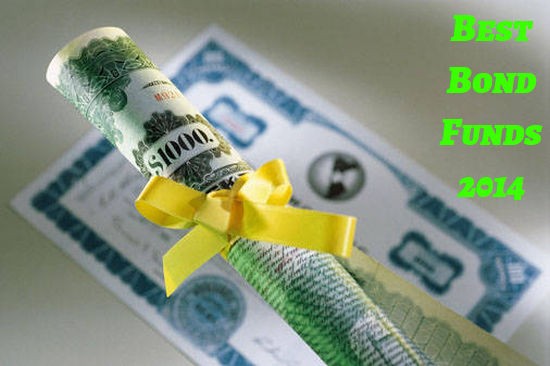The Five Best Bond Funds for 2014
Post on: 16 Октябрь, 2016 No Comment

What to be cautious of with rising interest rates possibly posing a big obstacle to bond funds
JewishWorldReview.com | Bond prices rose and yields fell almost without interruption for 30 years before 2013. With the benchmark ten-year Treasury bond paying just 2.9%, yields are still low by historical standards. Since 1962, the ten-year Treasury has yielded 6.3%, on average. So even a small improvement in the global economy should push yields higher in 2014, especially once the Federal Reserve starts paring back its aggressive bond-buying program in January.
With bonds facing these headwinds, I think investors should keep interest-rate sensitivity relatively low in the fixed-income portion of their portfolios. That means avoiding long-term bond funds and even many high-quality intermediate-term funds. I’d rather take my risks in 2014 owning funds that invest in bonds with lower credit quality.
But keep in mind that if the economy were to slide into recession in 2014, which I view as unlikely, not only would your stock funds be hammered, your lower-quality bond funds would take hits, too. High-quality bonds, by contrast, usually perform well when the economy tanks.
Here are my five favorite funds for 2014, listed in order from lowest to highest risk.
FPA New Income (symbol FPNIX) won’t make you rich, but neither will it send you to the poorhouse—even if rates shoot up. The fund’s primary objective is to avoid losses over any 12-month period, and it has met that goal since FPA took over management of the fund in 1984. Year to date, New Income has returned 0.8%. (All returns and yields are as of December 17 .)
New Income yields 3.2%, and the short-term nature of its holdings will minimize the damage if rates rise. The fund should lose about 2% if rates rise by one percentage point. I don’t think you’ll find another fund that takes as little risk and pays as generous a yield. Almost 80% of the fund is in bonds rated single-A and higher. The fund’s average credit quality is triple-B, the lowest investment-grade rating. More than half the fund’s assets are in U.S. government-backed securities. We’re belt-and-suspenders investors, says
Tom Atteberry
, who has co-managed the fund since 2004. The fund does have a chunk of its assets in lower-quality, non-government-backed commercial mortgages and asset-backed securities. Annual expenses are 0.58%.
Metropolitan West Unconstrained Bond (MWCRX) employs a proven strategy—with one major twist. The fund’s three co-managers have also piloted the $25 billion Metropolitan West Total Return (MWTRX), an intermediate-term bond fund, since 1997. Total Return is currently invested in a stew of mortgage securities, corporate bonds, asset-backed securities and emerging-markets bonds. All but 15% of the fund’s assets are rated investment grade. It returned an annualized 6.5% over the past ten years—an average of 1.9 percentage points more per year than Barclays U.S. Aggregate Bond index.
The main difference between Unconstrained and Total Return is that the former can short Treasury bonds—that is, bet on Treasuries to decline in price. Unconstrained’s current short positions sharply cut the fund’s exposure to rising interest rates. The fund would lose only 1.4% in price if yields were to rise one percentage point.
FREE SUBSCRIPTION TO INFLUENTIAL NEWSLETTER
Aside from betting against Treasuries, Unconstrained’s holdings are similar to Total Return’s. But if the managers are right, Unconstrained will avoid the pain of rising rates. The fund yields 2.1% and charges 0.99% in annual fees.
So far, returns have been excellent. Since Unconstrained’s inception in late 2011, the fund has returned an annualized 12.1%—an average of 10.5 percentage points per year more than the Barclays Aggregate index. Another plus: The fund is relatively undiscovered. Assets are a mere $624 million.
Loomis Sayles Bond
(LSBRX) has been one of the friskier bond funds since
Dan Fuss
launched it in 1991. Over the past ten years, the fund returned an annualized 7.8%—an average of 3.2 percentage points per year better than the Barclays Aggregate index. However, that stellar long-term record includes a 22.1% drop in 2008, when Barclays Aggregate gained 5.2%.
Fuss—the fund’s lead manager—and two co-managers believe the yield on ten-year Treasuries will rise to 4.5% to 5% in the next three to five years. Long-term, high-quality bonds are one of the riskiest investments you can make, says co-manager
Elaine Stokes
. That’s because the better a bond’s quality, the lower its yield and the more sensitive it is to changes in interest rates.
Accordingly, the Loomis managers are avoiding high-quality bonds. Indeed, the fund has an average credit quality of just triple-B (firmly in junk bond territory). Moreover, the fund has 10% of its assets in convertible securities, which can behave like stocks. About one-third of its assets are in short-term bonds denominated in foreign currencies, mainly in Canada. New Zealand and Norway. The fund, which charges 0.92% per year, yields 3.2%.
TCW Emerging Markets Income N (TGINX) isn’t for the faint of heart. Of course, the same could be said for just about all emerging-markets bond funds, which showed in 2013 that they are suitable for only a small part of a typical investor’s fixed-income allocation. The group got hammered because of fears of higher interest rates in the U.S. A stronger dollar also hurt investments denominated in foreign currencies.
But in many emerging markets the worst may be over. Countries that are growing at a rapid clip and have low debt levels as a percentage of gross domestic product may well see their currencies and their bonds recover. Unlike most of its peers, which invest almost entirely in dollar-denominated bonds or entirely in bonds issued in currencies of emerging markets, the TCW fund invests in both. It also owns both government bonds and corporates. I think that flexibility will pay off over time. Indeed, over the past five years, the fund returned an annualized 16.1%, putting it in the top 4% of emerging-markets bond funds. TCW, which lost 5.2% in 2013, yields a generous 6.5%. Annual expenses are 1.1%.

Vanguard Convertible Securities (VCVSX) isn’t, strictly speaking, a bond fund. It invests in convertible bonds—hybrids that are part stock and part bond. Like conventional bonds, convertibles pay some interest, though they yield less than ordinary bonds. But as their name implies, convertibles can be converted into stock at a preset price at any time.
When a convertible trades at or near a price at which conversion makes economic sense, it tends to closely track the issuer’s stock. Conversely, when a convertible is far below its conversion price, it trades almost entirely as a bond would, independent of movements in the stock’s price.
Larry Keele
, who is the Vanguard fund’s lead manager, and his two co-managers generally like convertibles that trade between those two extremes.
Their fund has been a winner. Over the past ten years, it returned an annualized 7.9%—beating Standard & Poor’s 500-stock index by an average of 0.7 percentage point per year. Yet it has been 20% less volatile than the S&P index.
Convertibles are risky. Almost all of them have junk ratings; this fund’s average credit rating is double-B. Although Keele, who has been on the fund since 1996, and his co-managers have a terrific record of avoiding defaults, Vanguard Convertible still lost 29.8% in 2008. The S&P 500 plunged 37% that year.
You can only buy the fund directly from Vanguard. But, in my view, it’s by far the best fund in its class. Expenses are just 0.52% annually, and the fund yields 2.2%.
How did my 2013 picks do? On average, the funds have returned negative 2.1% so far this year, compared with a loss of 1.6% for the Barclays Aggregate index. Pulling the average down was Pimco Emerging Local Bond D (PLBDX), which tumbled 10.2%. All of my other picks beat the index.
Sign up for the daily JWR update. It’s free. Just click here.
Interested in a private Judaic studies instructor — for free? Let us know by clicking here.
Comment by clicking here .
Steven Goldberg is a Contributing Columnist for Kiplinger.














